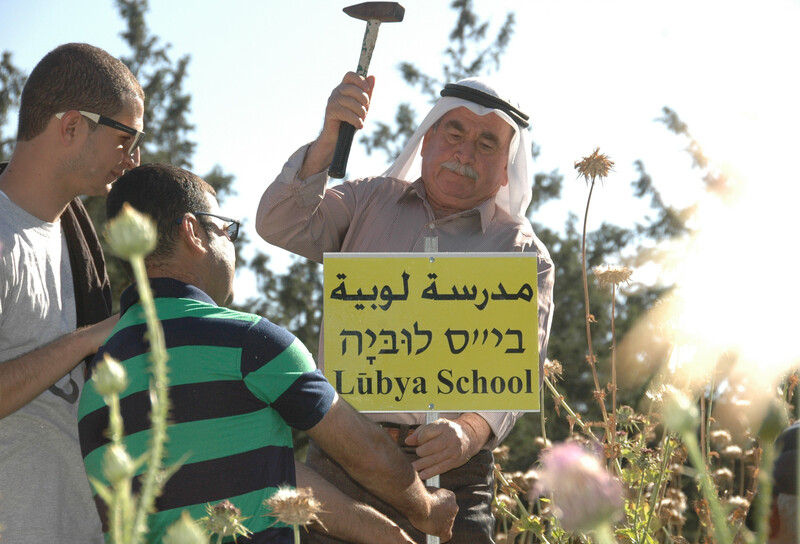The Electronic Intifada 5 May 2015

Palestinians displaced from Lubya place a sign where the village school once stood.
Many donors to the South Africa Forest in present-day Israel probably do not realize that they are helping to cover up the results of ethnic cleansing. Such details have been omitted from a Jewish National Fund website promoting the Lower Galilee project as environmentally sound and offering a certificate to anyone who finances the plantation of at least two trees.
Campaigners with the group Stop the JNF in South Africa are trying to highlight how the land where the forest is located was once the site of the Palestinian village of Lubya. It was destroyed by Zionist forces during the Nakba (Arabic for catastrophe), the forced displacement of Palestinians in 1948.
In a novel ceremony on 1 May, a number of South Africans who have previously given money to the JNF issued a public apology.
“Whether we knew it or not, the money that we donated to the JNF bought the seeds that grew into these trees that cover your houses, your wells and your sacred places,” Shereen Usdin, a South African Stop the JNF activist, said during a ceremony held at the forest.
“While this forest may be an attempt to erase the memory of Lubya, there can be no denying what happened here. These stones, these graves, these wells, these cacti plants, are all bearing witness. Now as Jewish South Africans we have come here to this forest and to the ruins of Lubya in order to acknowledge and to take responsibility for this injustice,” she added.
The ceremony took place in the forest following a tour of the destroyed village.
“While you are walking I invite you just to look around,” said Umar al-Ghubari, a representative of Zochrot (Hebrew for remembering), a group seeking to educate Israelis about the Nakba. “On both sides you will see ruins of houses. All these stones that you see around you are actually houses.”
“Another level of erasure”
The South Africa Forest is one of 86 public parks across Israel that sit on ethnically cleansed Palestinian villages.
In order to remove any physical evidence of the villages’ destruction, the JNF has long been involved in covering villages with non-indigenous pine trees, which if not by design, had the effect of making the country look more European.
Several of these forests are funded by international donors.
According to Heidi Grunebaum, a South African writer and narrator of a film about Lubya titled The Village Under the Forest, the JNF worked to cultivate the idea of a Jewish homeland among diaspora Jews through tree planting. In more recent years, she said, the organization has shifted its image and begun marketing itself as an “environmental” or “eco-Zionist” organization.

Shereen Usdin speaks at a ceremony at the site of Lubya village.
“Given what South Africa’s history has been, there’s something abominable and unthinkable in Israel proclaiming a South Africa Forest not only on stolen land, but on land where there used to be a village,” Grunebaum, an organizer of the ceremony, told The Electronic Intifada. “It’s almost another level of erasure.”
Grunebaum’s film was one of the factors that influenced the activists with Stop The JNF to visit the forest and apologize to Lubya’s displaced residents.
The activists who came — twelve from South Africa and one from Australia — all either donated to the JNF in the past or had trees planted in their name.
“We wanted to publicly acknowledge how Palestinians have been displaced and dispossessed, and to let them know that there are Jewish people who support their struggle,” Jessica Sherman, one of the activists, told The Electronic Intifada. She had previously been involved in her own country’s struggle against apartheid.
“Greening as act of obliteration”
“We cannot undo the past,” said Usdin.
“However, as South Africans who continue to grapple with the legacy of land dispossession, we commit to challenging ‘greening’ as an act of obliteration. We see clearly the parallels with what is happening in historic Palestine and what has happened in our own country’s apartheid past,” she added.
Wakim Wakim, head of the Association for the Defense of the Rights of the Internally Displaced People in Israel, also spoke during the ceremony: “We have no problem living with Jews in this country. We want coexistence,” he said. “But coexistence here can only come after racism has ended.”
Several of the South African activists also noted how even though white minority rule was ended in their country, this does not mean that the model of South Africa holds all the answers for Palestine.
“People look to South Africa for hope and I think that’s great,” said Emma Daitz, one of the South African activists. “But the problem with that is that we had a transition that brought formal democracy but it didn’t bring social or economic change. The same people who were impoverished and dispossessed twenty years ago are still the same people today.”
Fathi al-Eidi, a refugee from Lubya who now lives in Taybeh village about three kilometers away, said he appreciated the event, but understood it was only symbolic.
“I am happy that people came,” he said. “To say sorry is always good. But I hope that one day all the people from Lubya can come back.”
Sarah Levy is an independent journalist living in the West Bank. Twitter: @levysarahm




